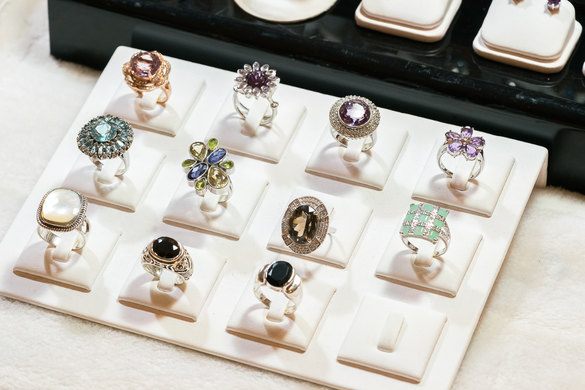Visual Merchandising Tips from India’s Expert Kshama Dalal Kumar

Although jewellery retailers in India have been waking up to the importance of Visual Merchandising, it is still an area that is not explored nearly enough as it is in the West. GemAtlas caught up with Kshama Dalalkumar, who is unanimously considered India’s Jewellery Visual Merchandising guru, and her husband Ajit Kumar, without whose technological prowess, she says, her creative ideas would never be executed as well as they are.
Kshama Dalalkumar has a background of graphic designing, as does Ajit. Kshama’s tryst with “Visual Merchandising” began about 27 years ago – probably before the name was even coined. A client she was working with asked her to design a jewellery booth for a trade show, and thus began her journey with 3-D merchandising, which quickly turned into a life-long passion.
Today, she undertakes stall designing for jewellery trade shows, is involved with showroom window displays, the complete interiors of jewellery showrooms, photography, as well as graphic designing.
Kshama Dalalkumar has a background of graphic designing, as does Ajit. Kshama’s tryst with “Visual Merchandising” began about 27 years ago – probably before the name was even coined. A client she was working with asked her to design a jewellery booth for a trade show, and thus began her journey with 3-D merchandising, which quickly turned into a life-long passion.
Today, she undertakes stall designing for jewellery trade shows, is involved with showroom window displays, the complete interiors of jewellery showrooms, photography, as well as graphic designing.
Here’s what Kshama had to say to GA:
GA: What according to you is the most important aspect of visual merchandising?
KD: Lighting is the single most important aspect. Different products require different types of lighting set-ups. Most often, I literally bring in different lights on the spot in the showroom where I visualise that I would like to display a particular type of jewellery, and we see how the products show up. Diamonds usually need white LED lights, gold shows up better with warmer lighting – often conventional types of light with the mixture of LED.
GA: What are the important factors that a retailer must take into account while planning visual merchandising?
KD: The most important aspect is to grab the attention of potential customers with the window. It’s impossible for people to notice the jewellery from afar. So, the window has to be a magnet. The presentation should be creative and create curiosity.
In the window, as well as inside the store, you need to create a visual flow that makes it easy for the person to look at one thing at a time in a sequence and to look at everything that is displayed.
In the case of displaying diamonds especially, I always advocate “less is more”. When it comes to gold, the customers sometimes tend to like to see a little more on display. This has to be decided looking at the brand and type of customers.
I recommend a grouping of similar products and only the best of each type of product or range in the display case. The customer should be made to ask to see more of a particular type of product.
GA: What is the process you undertake for Visual Merchandising?
KD: We overlook all the conceptualising, designing and execution in-house. I am the creative one, and my husband executes everything that I visualise, bringing it to life.
Firstly, I keep collecting things – beautiful things, unconventional things, seemingly useless things – everything that catches my fancy.
I insist on meeting the top decision-makers themselves.
I start out asking the client a lot of questions. I ask them what they are looking for – sophistication, beauty, etc; I ask them if they have any colour choices or dislikes; I ask them if they can tell me about any concepts they have liked in the past, so I can understand their tastes and thinking.
One of the first things I ask for is the logo. I study the branding and thebrand-identity. I ask for their advertising campaigns. I ask for past products.
Most often, we are involved with consultancy right from the time the interior designing is being done. We work with the architects closely.
I work the house colours or the logo and the general brand-identity into the designs.
Once I have my sketches ready, we create 3-D designs on the computer. Since it’s not always possible to be at every trade show assembling windows, etc for every client, we make the final assembling process as easy as possible. We teach the clients at our studio, how to assemble the window at the location. When I am present myself, I can add finishing touches, and yes the final product definitely does most often look even better.
We work first for our own satisfaction and then for our clients. Only if we are satisfied will the client be satisfied. Of course the customers have to be the primary focus. If I feel that the client’s mindset is constantly at loggerheads with what is right for the product and end-customer, I insist on the client stepping back till the final results are there for the seeing! After all, it’s my name that’s associated with the final product, and even just one bad result is bad for one’s image. But, this does not happen too often.
We associate ourselves with the most talented artists from every genre. We have a working relationship with paper sculptors, sculptors who work with stone and other materials, tribal artists – the list is endless.
Visual merchandising is a continuous process. I educate even the salespeople on how to place the products, present them, how to be attuned to peripheral issues like even a blown bulb!
GA: What according to you are the biggest visual merchandising mistakes that jewellery retailers make?
KD: In India, our props are often not of the best quality. The neckpiece displays, pads, etc, lack proper finish. Many years ago, even at Basel, we found people in the Indian pavilion using dirty, shabby and even torn props in their display windows. We approached them and offered our help free of cost. It was a matter of pride in the Indian contingency.
Colour combinations used for display are sometimes uncomplimentary and terrible even.
Often, people just use general lighting in showrooms. This is a great injustice to the products. You cannot use yellow light for diamonds, for example.
Enhancing photographs of jewellery with photoshop, etc, which is a very common practice, is also not correct. Customers then come back and say “this is not what I thought I was buying”, if they are buying online, for example. Photographs are often used as part of the visual props in windows or showrooms as well. We do not touch up our photographs. Yet, our pictures are wonderful.
Of course, things are getting better now. GJEPC has been getting us to talk to the trade about why and how important presentation and visual merchandising is.
GA: What are your suggestions for incorporating holiday season themes into window displays and visual merchandising as a whole?
KD: In India, there’s a lot that can be done during holiday seasons of Dussehra, Diwali, Holi, Navratri, Ganesh Chaturthi, and even the Wedding season. Then there’s Christmas and Valentine’s Day. Besides the holidays, even the themes that the companies undertake one after the other can be looked at in a similar vein to the holiday seasons.
My advice is to not use very literal props in the concepts but to use creative shapes and forms to symbolically denote the concept and create impressions. Don’t use a pichkari for holi but play with colours. Don’t use a diya for Diwali, but play with its concept graphically.
GA: Are there any final visual merchandising secrets you would be willing to share with GA members?
KD: The most important thing is that things don’t end after the display is finished – Everything else has to go hand-in-hand. Keep rotating your products. Don’t let the customers keep seeing the same products. That will tell terribly on sales from your regular visitors.
Educate your salespeople on the importance of maintaining proper visual elements. Jewellery should not be put back shabbily or crooked, broken props and other issues should be dealt with immediately.
Do not overshadow the product. The product should be the focal point.
Put some literature about your product next to the window or display. That way people can have their questions answered.
If the product-collection has some special theme or inspiration, use that as the theme for the display too.
As Kshama and Ajit have been doing for almost three decades now, Visual Merchandising should indeed be used as a formidable tool to attract customers and promote products. If you cannot afford to hire a visual merchandiser, you should look for creative talent from among your staff. Perhaps you can get a designated person some training in the field. As Kshama and Ajit pointed out to us, props do not necessarily have to be expensive, they just need to be creative, presentable, and serve the purpose of creating an attraction.
Here’s to your visual merchandising success!

